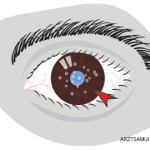
Prostock-studio / shutterstock.com
ACR CONVERGENCE 2021—Rheumatic conditions can affect the eye in myriad ways, but ocular inflammation can be challenging for the rheumatologist to understand and manage. Jason Kolfenbach, MD, associate professor of medicine and ophthalmology, and program director of the Rheumatology Fellowship Program, University of Colorado School of Medicine, Aurora, and Alan G. Palestine, MD, professor of ophthalmology and medicine, and chief of the Uveitis and Ocular Immunology Section, University of Colorado School of Medicine, provided a unique overview of inflammatory eye disease and the overlap with systemic rheumatic illnesses at an ACR Convergence 2021 session.
Rheumatology & the Eye
Dr. Kolfenbach discussed the intersection between rheumatology and ophthalmology with an intriguing case-based presentation. “The eye is a common target of many rheumatic illnesses,” he said. “Most inflammatory eye disease is idiopathic, but studies estimate 25 to 40% of uveitis and more than 50% of nodular or necrotizing scleritis are associated with an underlying systemic illness.”1,2
First, Dr. Kolfenbach shared the case of a young woman with Cogan syndrome, which is characterized by acute-onset ocular and audiovestibular signs within one to six months of each other. Interstitial keratitis, bilateral sensorineural hearing loss and vestibular dysfunction are classic presentations, although other manifestations may occur. These patients may also experience constitutional symptoms, joint pain, lymphadenopathy and a medium- to large-vessel vasculitis, which occurs in 15–20% of cases. Treatment depends on the manifestation present, with ocular disease responding well to topical steroids, hearing loss to oral immunosuppressants like methotrexate or azathioprine, and vasculitis typically requiring cyclophosphamide.3
Next, he turned to the case of a 69-year-old gentleman with untreated ankylosing spondylitis and unilateral anterior uveitis. His exam was notable for ciliary flush in the limbus region of the eye and synechiae. “White blood cells and protein in the anterior chamber cause stickiness between the iris and lens, resulting in synechiae—which is essentially an adhesion between these two structures in the eye,” Dr. Kolfenbach explained. He offered the following pearl: “If unilateral uveitis is recurrent, spondyloarthritis (SpA) comprises nearly half of cases, so we need to identify and intervene earlier to ensure better SpA outcomes over time.”
Uveitis may often feel like the tip of the iceberg, with a laundry list of infectious malignant and inflammatory conditions as potential etiologies. So where does one start? Dr. Kolfenbach recommended approaching the differential based on the anatomic segment of the eye involved. For recurrent uveitis cases, he recommends:



